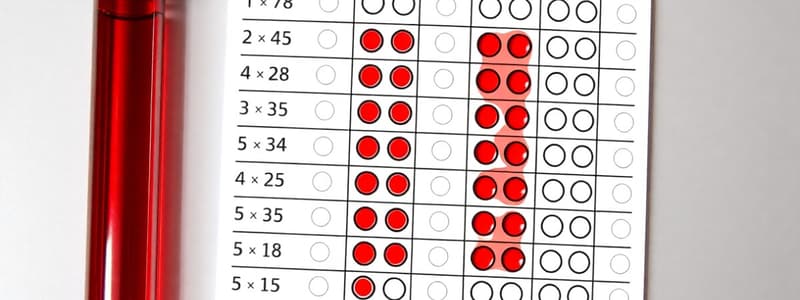Podcast
Questions and Answers
A patient's lab results show a leukocyte concentration of 15 K/uL. Assuming no other information, which condition is LEAST likely to contribute to this result?
A patient's lab results show a leukocyte concentration of 15 K/uL. Assuming no other information, which condition is LEAST likely to contribute to this result?
- Leukemia
- Steroid use
- Severe bacterial infection
- Aplastic anemia (correct)
Which of the following scenarios would MOST likely result in a falsely elevated platelet count using an electronic cell counter?
Which of the following scenarios would MOST likely result in a falsely elevated platelet count using an electronic cell counter?
- EDTA-induced platelet clumping
- Significant red blood cell fragmentation (correct)
- Clotted sample
- Presence of cryoglobulins
A patient presents with fatigue and pallor. Lab results show a hemoglobin level of 9 g/dL and a mean cell hemoglobin concentration (MCHC) of 30 g/dL. Which condition is MOST consistent with these findings?
A patient presents with fatigue and pallor. Lab results show a hemoglobin level of 9 g/dL and a mean cell hemoglobin concentration (MCHC) of 30 g/dL. Which condition is MOST consistent with these findings?
- Hereditary spherocytosis
- Thalassemia
- Iron deficiency anemia (correct)
- Autoimmune hemolytic anemia
A patient's anion gap is calculated to be 30 mmol/L. Which of the following conditions is LEAST likely to be the cause of this elevated anion gap?
A patient's anion gap is calculated to be 30 mmol/L. Which of the following conditions is LEAST likely to be the cause of this elevated anion gap?
A jaundiced patient has the following bilirubin results: Total bilirubin: 5.0 mg/dL, Direct bilirubin: 4.0 mg/dL, Calculated Indirect bilirubin: 1.0 mg/dL. These results suggest which condition?
A jaundiced patient has the following bilirubin results: Total bilirubin: 5.0 mg/dL, Direct bilirubin: 4.0 mg/dL, Calculated Indirect bilirubin: 1.0 mg/dL. These results suggest which condition?
Following significant muscle trauma, a patient's creatine kinase (CK) level is markedly elevated at 2000 U/L. Which CK isoenzyme is MOST likely responsible for this elevation?
Following significant muscle trauma, a patient's creatine kinase (CK) level is markedly elevated at 2000 U/L. Which CK isoenzyme is MOST likely responsible for this elevation?
A patient's electrolyte panel reveals the following: Sodium 125 mmol/L, Potassium 6.0 mmol/L, Chloride 90 mmol/L. Which of the following conditions would LEAST likely contribute to this electrolyte imbalance?
A patient's electrolyte panel reveals the following: Sodium 125 mmol/L, Potassium 6.0 mmol/L, Chloride 90 mmol/L. Which of the following conditions would LEAST likely contribute to this electrolyte imbalance?
A patient’s alkaline phosphatase level is significantly elevated. To further investigate the cause, which additional test would be MOST helpful in differentiating between hepatic and bone origins?
A patient’s alkaline phosphatase level is significantly elevated. To further investigate the cause, which additional test would be MOST helpful in differentiating between hepatic and bone origins?
A patient with known liver disease has a prolonged prothrombin time. Which of the following abnormalities is MOST likely responsible for this finding?
A patient with known liver disease has a prolonged prothrombin time. Which of the following abnormalities is MOST likely responsible for this finding?
A dehydrated patient has the following lab results: Sodium 150 mmol/L, Blood Urea Nitrogen (BUN) 35 mg/dL, Creatinine 1.5 mg/dL. What is the MOST likely explanation for the elevated BUN and creatinine levels?
A dehydrated patient has the following lab results: Sodium 150 mmol/L, Blood Urea Nitrogen (BUN) 35 mg/dL, Creatinine 1.5 mg/dL. What is the MOST likely explanation for the elevated BUN and creatinine levels?
A patient is suspected of having primary hyperparathyroidism. Which set of lab results would BEST support this diagnosis?
A patient is suspected of having primary hyperparathyroidism. Which set of lab results would BEST support this diagnosis?
A critically ill patient has a serum albumin level of 2.5 g/dL. How might this hypoalbuminemia affect the interpretation of their total calcium level?
A critically ill patient has a serum albumin level of 2.5 g/dL. How might this hypoalbuminemia affect the interpretation of their total calcium level?
A bone marrow disorder causes an increase in non-segmented neutrophils. How will this affect the Complete Blood Count?
A bone marrow disorder causes an increase in non-segmented neutrophils. How will this affect the Complete Blood Count?
Which condition will cause the most significant increase in indirect bilirubin?
Which condition will cause the most significant increase in indirect bilirubin?
A patient has a low potassium level that is not resolving. Which serum chemistry result could explain why supplementation is not effective?
A patient has a low potassium level that is not resolving. Which serum chemistry result could explain why supplementation is not effective?
Consider a patient with end-stage renal disease. In addition to electrolyte imbalances, which hematological abnormality is MOST likely to be observed?
Consider a patient with end-stage renal disease. In addition to electrolyte imbalances, which hematological abnormality is MOST likely to be observed?
A patient's lab results show an elevated eosinophil count. Which of the following is LEAST likely to be the cause of this result?
A patient's lab results show an elevated eosinophil count. Which of the following is LEAST likely to be the cause of this result?
Which of the following blood gas / electrolyte panel results would be most indicative of metabolic alkalosis?
Which of the following blood gas / electrolyte panel results would be most indicative of metabolic alkalosis?
After prolonged vomiting, a patient's chloride level is low. How will this affect the bicarbonate level?
After prolonged vomiting, a patient's chloride level is low. How will this affect the bicarbonate level?
How do the Leukocyte and Lymphocyte concentrations compare?
How do the Leukocyte and Lymphocyte concentrations compare?
Flashcards
Leukocyte Concentration
Leukocyte Concentration
White blood cell count; normal range is 6-14 K/uL.
Segmented Neutrophil Count
Segmented Neutrophil Count
A type of white blood cell; normal range is 2.5-5.0 K/uL.
Band Neutrophil Concentration
Band Neutrophil Concentration
Immature neutrophil; normal range is 0-0.15 K/uL.
Lymphocyte Concentration
Lymphocyte Concentration
Signup and view all the flashcards
Monocyte Concentration
Monocyte Concentration
Signup and view all the flashcards
Eosinophil Concentration
Eosinophil Concentration
Signup and view all the flashcards
Basophil Concentration
Basophil Concentration
Signup and view all the flashcards
Erythrocyte Concentration
Erythrocyte Concentration
Signup and view all the flashcards
Hemoglobin
Hemoglobin
Signup and view all the flashcards
Hematocrit
Hematocrit
Signup and view all the flashcards
Mean Cell Hemoglobin (MCH)
Mean Cell Hemoglobin (MCH)
Signup and view all the flashcards
Mean Cell Hemoglobin Concentration (MCHC)
Mean Cell Hemoglobin Concentration (MCHC)
Signup and view all the flashcards
Platelet (Electronic) Count
Platelet (Electronic) Count
Signup and view all the flashcards
Fibrinogen Concentration
Fibrinogen Concentration
Signup and view all the flashcards
Glucose
Glucose
Signup and view all the flashcards
Sodium
Sodium
Signup and view all the flashcards
Potassium
Potassium
Signup and view all the flashcards
Calcium (Total)
Calcium (Total)
Signup and view all the flashcards
Phosphorus
Phosphorus
Signup and view all the flashcards
Albumin
Albumin
Signup and view all the flashcards
Study Notes
Complete Blood Count
- Leukocyte concentration normal range is 6-14 K/uL.
- Segmented neutrophil count normal range is 2.5-5.0 K/uL.
- Band neutrophil concentration normal range is 0-0.15 K/uL.
- Lymphocyte concentration normal range is 1.5-7.7 K/uL.
- Monocyte concentration normal range is 0.1-1 K/uL.
- Eosinophil concentration normal range is 0-1 K/uL.
- Basophil concentration normal range is 0-0.2 K/uL.
- Erythrocyte concentration normal range is 6-12 M/uL.
- Hemoglobin normal range is 11-18 g/dL.
- Hematocrit normal range is 32-50%.
- Mean cell hemoglobin normal range is 12-19 pg.
- Mean cell hemoglobin concentration normal range is 34-37 g/dL.
- Platelet (electronic) normal range is 100-350 K/uL.
- Fibrinogen concentration normal range is 100-400 mg/dL.
Serum Chemistry Normal Values
- Glucose normal range is 80-110 mg/dL.
- Sodium normal range is 134-143 mg/dL.
- Chloride normal range is 95-113 mmol/L.
- Potassium normal range is 2.4-5.6 mmol/L.
- Calcium (total) normal range is 11.2-13 mg/dL.
- Phosphorus normal range is 2.3-4.4 mg/dL.
- Total protein normal range is 6.1-7.4 g/dL.
- Albumin normal range is 3-3.7 g/dL.
- Globulin normal range is 2.7-4.0 g/dL.
- Bicarbonate normal range is 22-34 mmol/L.
- Anion gap normal range is 19-24 mmol/L.
- Creatinine normal range is 0.9-1.7 mg/dL.
- Urea nitrogen normal range is 9-20 mg/dL.
- Aspartate transaminase normal range is 199-413 U/L.
- Alkaline phosphatase normal range is 75-220 U/L.
- Gamma glutamyltransferase normal range is 8-33 U/L.
- Creatine (phospho) kinase normal range is 93-348 U/L.
- Bilirubin, total normal range is 0.7-2.6 mg/dL.
- Bilirubin, direct normal range is 0.1-0.3 mg/dL.
- Bilirubin, indirect (calculated)
Blood Gas / Electrolyte Panel
- Sodium normal range is 133.8 - 141.0 mmol/L.
- Potassium normal range is 2.7 - 4.6 mmol/L.
- Chloride normal range is 100.0 – 107.0 mmol/L.
- Calcium normal range is 5.5-6.2 mg/dL.
- Magnesium normal range is 0.9-1.4 mg/dL.
Studying That Suits You
Use AI to generate personalized quizzes and flashcards to suit your learning preferences.




